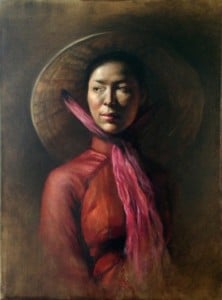
Observing, by Ifat Glassman
Many readers of The Objective Standard enjoyed Ifat Glassman’s portrait of Ayn Rand, which adorned the cover of the Fall 2012 issue of the journal, so I’ve decided to share some more of her works here along with a brief interview with Ms. Glassman. —Craig Biddle
Craig Biddle: Thank you again, Ifat, for the beautiful portrait of Ayn Rand—and now also for taking time to tell our readers a little about yourself and your work. How did you get involved in the arts?
Ifat Glassman: I’ve been drawing since I was a kid. At first, I would draw cartoons and princesses. Later, I drew fashion designs, farriers, and various figures. I was enchanted by all the old, animated Disney movies and fascinated by the imagination and skill that went into making them.
When I was twelve, my family took me to the Louvre museum in Paris, and this was the first time I was exposed to the world of classical realism, which is what I’m studying now. That trip really inspired me and broadened my understanding of what can be done. Later that year my parents bought me an easel and some oil paints, and I started producing oil paintings for the first time, which further fascinated me with the possibilities.
Ever since high school, I’ve always carried a sketchbook with me—I’ve always been drawing or painting something. So I think I could say that instead of getting involved in art, I was always involved and simply never dropped out.
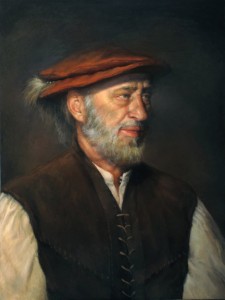
The Merchant, by Ifat Glassman
CB: I understand you’re currently studying at the Georgetown Atelier. What is an atelier? And what’s involved in studying at Georgetown?
IG: An atelier is an art school that uses a certain type of regimented training in representational art. To the best of my knowledge, such schools were prevalent from the Middle Ages through the 19th century, then all but disappeared. Only recently, in the past fifteen years or so, have they reemerged.
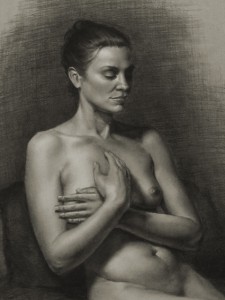
Introverted, by Ifat Glassman
In the old times, an atelier involved one master artist and a small group of students, or apprentices. The students would live with the master and study rigorously for seven or so years, pretty much every day, all day. At first, students would only do “master copies,” which means copies of works of accomplished artists, and only in charcoal. Later, they would draw from casts of sculptures, which would teach them to see and render value. Eventually they were permitted to work from a live model. It typically took years before they started working in paint, and even then they would start with only one color and gradually use more. The education would last about seven years, after which the student was regarded as ready to work on his or her own and was considered “an artist.”
To pay for the training, students would do work for the master—stretch his canvases, clean his brushes, or whatever. Today, of course, we just pay tuition; the programs are not as long (mine is only three years); and we get to work with live models sooner. Thank goodness! But the general idea and method of education are essentially the same.
My program teaches realism—not photographic realism, but classical or stylized realism—in which the artist emphasizes or de-emphasizes aspects of the subject and makes alterations to what he sees in accordance with his vision of what’s important and worthy of focus. We work from a live model every morning and from still life objects in the afternoons.
I’ve learned a lot at Georgetown Atelier, and I recommend atelier education for anyone who is serious about a career as a painter.
CB: What are your favorite media and why?
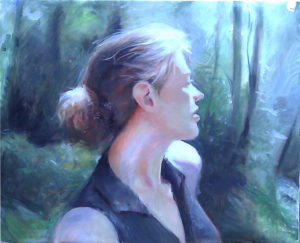
Forest Light, by Ifat Glassman
IG: My favorite medium is oil paint, although on some days, when I’m having a hard time with a painting, I will certainly not answer that way. But I generally like oil paint more than anything else. It produces richer, more vibrant colors than other paints, and because you can move the paint for longer periods of time, you have more flexibility—you can easily create something quickly, or you can take your time and rework things over and over.
That said, I like other media as well. I especially like pencil drawing because it affords great precision and control.
CB: What are your favorite subjects to paint or draw?
IG: Mostly I like painting figures, human beings. I like to capture moods, character traits, and emotions, and I like telling stories using settings, facial expressions, posture, and body language. I am also fascinated by and like working with light and the way light interacts with figures and objects.
CB: Of your drawings and paintings, which are your favorites, and why?
IG: One of my favorites is “Journey,” a monochromatic painting I did in 2011. I like it because it really expresses how I felt at the time and because, while I was working on it, I felt like I had traveled to the world I was painting. I like “The Merchant,” which I think is my best work in terms of the technique. I also like my drawing “Introverted” for the emotion it conveys and for the rendering. And I like “Forest Light” because it was entirely my own creation—I did it outside the atelier—and I like the effect of the light and the expression on the woman’s face.
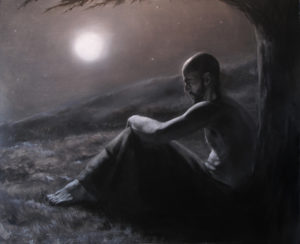
Journey, by Ifat Glassman
CB: Who are your artistic inspirations?
IG: They are numerous, but a few are Herbert James Draper, a great Renaissance artist; Adolphe William Bouguereau, an expert technician; Robert Liberace, who has a bold and powerful style; Michael Newberry, whose work has great emotional depth; and Brian Larsen, whose paintings have wonderful themes.
CB: Your portrait of Ayn Rand, which I proudly own, is strikingly original and beautiful. Tell me about your thinking in preparation for that, and the process by which you created it.
IG: Before I started it, I knew I really wanted to emphasize an aspect of Ayn Rand that I cherish, but that often gets overlooked, and that is her joy and love of life. Her enjoyment of life, of the world, of her work and goals, of the things and people she loved—that is what life is all about. Many people are aware of her intelligence, her strong convictions, and her justified anger about the injustices she saw in the world; but too few, it seems, are aware of her great joy and happiness. That’s a large part of what I wanted to convey.
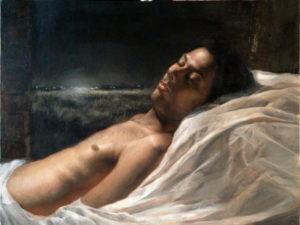
At Rest, by Ifat Glassman
When I was working on the drawing, I felt like I was having a wordless conversation with a friend. I would unintentionally mimic the expression I wanted the portrait to have, then draw it that way. I wanted to capture Ayn Rand’s intensity, her joy, her pride, and her beauty. I usually focus more on the technique, on the “how” of creating a work of art,” but in this case I focused primarily on the “what,” on what I wanted it to convey.
CB: What are your plans for the future?
IG: I’ll be graduating in June! I plan to start working right away and painting all the ideas I’ve accumulated in the last few years. Ultimately, I want to find a gallery to represent me and sell my work. I will also likely teach, which I love to do and which helps to hone the skills.
CB: Where can people see your work?
IG: My website, where I also blog, is www.ifatart.com. I can also be found on Facebook—just search for Ifat Glassman Art.
CB: Thank you for your time, Ifat, and for sharing these images with our readers.
IG: My pleasure—thank you for your interest in my work!















